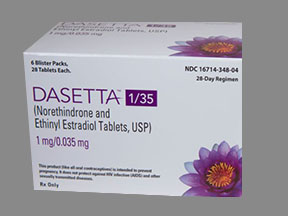
Dasetta 1/35 (28) Coupons & Savings Card – Discount Prices from $11.42
My prescription
Edit
1-35MG-MCG, Dasetta 1/35 (28) (30 Tablets)
Select pharmacy

CVS
$20.19
COUPON PRICE
Walmart
$11.42
COUPON PRICE
Walgreens
$13.44
COUPON PRICE
Albertsons
$13.95
COUPON PRICEDasetta 1/35 (28) savings card
Show this card to your pharmacist
Walmart
$11.42
BIN
ID
PCN
GRP
019876
LH667F38ED
CHIPPO
LHX
Powered by
Price history for Dasetta 1/35 (28)
30 Tablets, 1-35MG-MCG
Average retail price for Dasetta 1/35 (28)
Average SaveHealth price for Dasetta 1/35 (28)
Our price history data is based on aggregated prescription data collected from participating pharmacies in America. Our prescription data updates daily to reflect the latest price changes. If you notice a missing data point, it means there wasn't sufficient data available to generate a monetary value for that date.
*Retail prices are based on pharmacy claims data, and may not be accurate when we don't have enough claims.
Dasetta 1/35 (28) dosage forms
Dosage Quantity Price from Per unit 1-35MG-MCG 30 Tablets $11.42 $0.38 1-35MG-MCG 60 Tablets $20.34 $0.34 1-35MG-MCG 90 Tablets $24.57 $0.27
| Dosage | Quantity | Price from | Per unit |
|---|---|---|---|
| 1-35MG-MCG | 30 Tablets | $11.42 | $0.38 |
| 1-35MG-MCG | 60 Tablets | $20.34 | $0.34 |
| 1-35MG-MCG | 90 Tablets | $24.57 | $0.27 |
Dasetta 1/35 (28) Warnings
When considering Dasetta 1/35 28, it's important to be aware of certain risks associated with its use:
Cardiovascular Risks: This medication may increase the risk of serious cardiovascular events, such as blood clots, heart attacks, and strokes. The risk is higher in women who smoke, especially those over 35 years old. Therefore, it's advisable for women over 35 who smoke to avoid using this contraceptive.
Blood Clots: The use of combination oral contraceptives like Dasetta 1/35 28 can elevate the risk of developing blood clots, including deep vein thrombosis (DVT) and pulmonary embolism (PE). This risk is further increased in women who are obese, have a history of blood clots, or possess certain inherited blood clotting disorders.
Cancer Risks: Some studies suggest a possible association between the use of hormonal contraceptives and an increased risk of breast and cervical cancers. It's important to discuss your individual risk factors with your healthcare provider.
Other Health Conditions: Dasetta 1/35 28 may not be suitable for women with certain health conditions, such as liver disease, certain types of migraines, uncontrolled high blood pressure, or a history of hormone-related cancers. Providing your healthcare provider with a complete medical history is crucial before starting this medication.
Pregnancy and Breastfeeding: This contraceptive should not be used during pregnancy. If you become pregnant or suspect you might be pregnant, discontinue use and consult your healthcare provider. Additionally, if you are breastfeeding, consult your healthcare provider before starting Dasetta 1/35 28, as it may affect milk production and pass into breast milk.
Surgical Procedures and Immobility: If you require major surgery or will be on long-term bed rest, inform your healthcare provider, as you may need to stop using this medication temporarily due to an increased risk of blood clots.
It's essential to thoroughly discuss these risks with your healthcare provider to determine if Dasetta 1/35 28 is appropriate for you and to minimize potential health risks.
Dasetta 1/35 (28) Side Effects
Dasetta 1/35 is a combination oral contraceptive containing norethindrone and ethinyl estradiol, used to prevent pregnancy. While effective, it may cause side effects ranging from mild to serious. Common Side Effects:
- Nausea and Vomiting: Some users may experience stomach discomfort, especially when starting the medication.
- Headaches: Mild to moderate headaches can occur.
- Breast Tenderness: Sensitivity or discomfort in the breast area is possible.
- Breakthrough Bleeding or Spotting: Unexpected bleeding between periods may happen, particularly during the first few months of use.
- Fluid Retention: Swelling in the ankles or feet due to water retention might be noticed. Serious Side Effects: Although less common, some side effects require immediate medical attention:
- Blood Clots: Symptoms may include sudden leg pain, chest pain, shortness of breath, or coughing up blood.
- Stroke: Signs include sudden numbness or weakness, severe headache, confusion, trouble speaking, or vision problems.
- Heart Attack: Indicators are chest pain or pressure, pain spreading to the jaw or shoulder, nausea, or sweating.
- Liver Problems: Look for yellowing of the skin or eyes, dark urine, light-colored stools, or persistent abdominal pain.
- High Blood Pressure: Severe headaches, blurred vision, or dizziness may signal elevated blood pressure. Warnings:
- Smoking: Smoking while using Dasetta 1/35 significantly increases the risk of serious cardiovascular events, especially in women over 35.
- Existing Health Conditions: Inform your healthcare provider if you have a history of blood clots, heart disease, liver problems, or severe migraines, as Dasetta 1/35 may not be suitable for you. It's essential to discuss your medical history and any concerns with your healthcare provider before starting Dasetta 1/35 to ensure it's the right contraceptive choice for you.
Dasetta 1/35 (28) Interactions
When taking Dasetta 1/35, it's important to be aware of potential interactions with other medications, foods, and certain health conditions. This oral contraceptive contains Ethinyl Estradiol and Norethindrone, which can interact with various substances, potentially affecting its effectiveness or increasing the risk of side effects.
Drug Interactions:
Dasetta 1/35 may interact with a wide range of medications. Some drugs can decrease the effectiveness of Dasetta 1/35, increasing the risk of unintended pregnancy. These include certain seizure medications (like Carbamazepine and Phenytoin), antibiotics (such as Rifampin), and herbal supplements like St. John's wort. On the other hand, some medications, such as daridorexant, may increase the blood levels of norethindrone, potentially leading to enhanced side effects. Additionally, ethinyl estradiol can increase the blood levels of Propranolol, which may cause greater decreases in blood pressure and heart rate. It's crucial to inform your healthcare provider about all medications and supplements you're currently taking to assess potential interactions.
Food and Lifestyle Interactions:
Certain foods and beverages can also affect how Dasetta 1/35 works. Grapefruit juice, for instance, may increase the blood levels of norethindrone, potentially leading to increased side effects. It's advisable to limit grapefruit consumption while on this medication. Additionally, smoking cigarettes while taking combination oral contraceptives like Dasetta 1/35 significantly increases the risk of serious cardiovascular events, especially in women over 35 years old. Therefore, it's recommended that women over 35 who smoke should not use combination oral contraceptives.
Disease Interactions:
Individuals with certain health conditions should exercise caution when using Dasetta 1/35. For example, those with high blood pressure may experience further increases in blood pressure while on this medication, elevating the risk of heart-related issues. Similarly, individuals with high cholesterol levels might see significant elevations in triglyceride levels, which can lead to pancreatitis. It's essential to discuss your full medical history with your healthcare provider to determine if Dasetta 1/35 is appropriate for you.
Always consult with your healthcare provider before starting or stopping any medication, including Dasetta 1/35, to ensure it's safe and effective for your individual health needs.
What is Dasetta 1-35 generic for?
Dasetta 1-35 is a generic form of the oral contraceptive known as Ortho-Novum 1/35. It contains a combination of ethinyl estradiol and norethindrone.
Is dasetta a combination pill?
Yes, Dasetta is a combination oral contraceptive pill that contains both estrogen and progestin.
Do you ovulate on Dasetta?
Dasetta is a combination oral contraceptive pill that typically works by preventing ovulation. When taken correctly, it suppresses the release of an egg from the ovary, thereby reducing the likelihood of ovulation. However, no contraceptive method is 100% effective, so there is a very small chance that ovulation could still occur.
What is Dasetta generic for?
Dasetta is a generic form of the oral contraceptive known as Ortho-Novum. It contains a combination of the hormones norethindrone and ethinyl estradiol.
How does Dasetta birth control work?
Dasetta birth control works primarily by preventing ovulation, which means it stops the ovaries from releasing an egg. Additionally, it thickens the cervical mucus, making it more difficult for sperm to reach any egg that might be released. It also alters the uterine lining, reducing the likelihood of implantation. These combined actions effectively prevent pregnancy.
